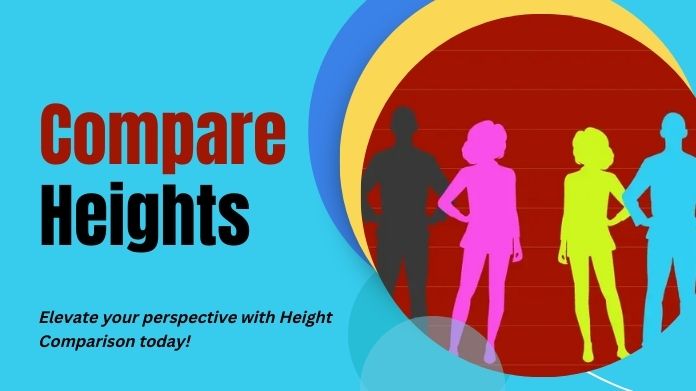Welcome to a visual odyssey that transcends the boundaries of height, inviting you to “Compare Heights Like Never Before” through the lens of the Height Comparison.
We explore human stature, architectural wonders, and natural marvels in this immersive journey. More than a mere measurement tool, the Height Comparison Chart becomes a dynamic narrative where historical figures, iconic landmarks, and the intricacies of the natural world converge.
Join us as we navigate this visual tapestry, offering fresh perspectives on the vertical dimensions that shape our understanding of scale and proportion.
Let the Height Comparison Chart be your guide to a heightened appreciation of the diverse heights that define our world.
What is Compare Heights Mean?

“Compare Heights” refers to evaluating and contrasting the vertical dimensions or statures of different objects, individuals, or entities. This process involves assessing the height of one entity about another, often to understand the scale, proportion, or magnitude of the subjects being compared.
For example, when using a Height Comparison Chart or visual aid, “compare heights” involves looking at representations of different heights, whether in the context of people, buildings, or natural features. This comparison allows for a clearer understanding of how the heights of various elements relate to one another.
In essence, “compare heights” quantifies and visualizes the differences in elevation or stature between different entities, providing insights into their relative sizes or dimensions.
What is Height Comparison?
Height comparison refers to assessing and contrasting the vertical dimensions or stature of different objects, individuals, or entities.
This process often involves using visual aids, such as charts, diagrams, or interactive platforms, to represent the varying heights in a relatable and easily understandable manner.
Height comparison can be applied to diverse contexts, including:
- Human Stature: Comparing the heights of individuals, historical figures, or groups to gain insights into the diversity of human dimensions.
- Architectural Scale: Assessing the heights of buildings, structures, or landmarks to understand their magnitude and place them in perspective.
- Natural Features: Exploring the heights of natural formations, such as mountains or waterfalls, to appreciate the grandeur of the natural world.
- Educational Tools: Utilizing height comparison charts as educational resources in classrooms, museums, or online platforms to facilitate learning about dimensions and proportions.
The goal of height comparison is to provide a visual representation that enhances understanding and appreciation of the vertical elements that contribute to the physical and visual landscape.
Concept of Height Comparison Chart

A Height Comparison Chart visually represents and compares the vertical dimensions of various objects, individuals, or structures clearly and comprehensively.
This chart serves as a graphical tool that allows for straightforward interpretation of height differences, offering insights into the scale and proportions of different entities.
Key aspects of the Height Comparison Chart concept include:
- Visual Representation: The primary function of the chart is to visually depict height differences using graphical elements such as bars, lines, or icons. This visual representation enhances understanding and facilitates quick comparisons.
- Versatility: Height Comparison Charts are versatile and can be applied to various contexts, including human stature, architectural heights, natural features, and more. This adaptability makes them valuable across different fields and disciplines.
- Educational Aid: The charts are often used as educational tools in classrooms, museums, and online platforms to teach concepts related to dimensions, scale, and proportion.
- Interactive Platforms: With advancements in technology, Height Comparison Charts have evolved into interactive platforms, allowing users to customize comparisons, explore different categories, and engage with the content dynamically.
- Historical and Cultural Significance: Height Comparison Charts may have historical and cultural significance, showcasing the heights of notable figures or landmarks and providing a visual narrative of human achievements and natural wonders.
In essence, the concept of a Height Comparison Chart facilitates a deeper understanding of heights and dimensions by presenting complex information in a visually accessible and engaging format.
How to Calculate Height Using Height Comparison Chart?
Calculating height using a Height Comparison Chart involves comparing the known height of a reference object or person to the corresponding measurement on the chart.
Follow these steps to calculate height:
Identify the Reference Object:
- Choose a reference object or person with a known height. This could be yourself, another person, or a commonly known object with a standard height.
Locate the Reference Height on the Chart:
- Find the representation of the reference object’s height on the Height Comparison Chart. This is typically indicated by a line, bar, or other visual element.
Trace Across to the Unknown Height:
- Once you’ve located the reference height, trace across the chart to the point representing the unknown height you want to calculate. This may involve drawing an imaginary line or following the chart’s visual cues.
Read the Corresponding Height:
- Look for the value or measurement associated with the point you traced to. This value represents the calculated height of the object or person you are trying to determine.
Consider Scale and Proportion:
- Keep in mind the scale and proportion of the Height Comparison Chart. Ensure that the chart provides accurate representations and use the measurements accordingly.
It’s important to note that the accuracy of the calculated height depends on the precision and reliability of the Height Comparison Chart.
Additionally, variations in chart design, scale, and measurement units can impact the accuracy of calculations. Always refer to the specific guidelines and information provided with the chart for the most accurate results.
Conclusion
In a world where every height tells a story, let this chart be your guide—an open invitation to compare heights like never before, unlocking a fresh perspective on the scale and proportion surrounding us.
As we continue to navigate the vertical dimensions of our existence, may the Height Comparison Chart serve as a steadfast companion, unravelling the tales written in height and offering a continuous journey of discovery.






